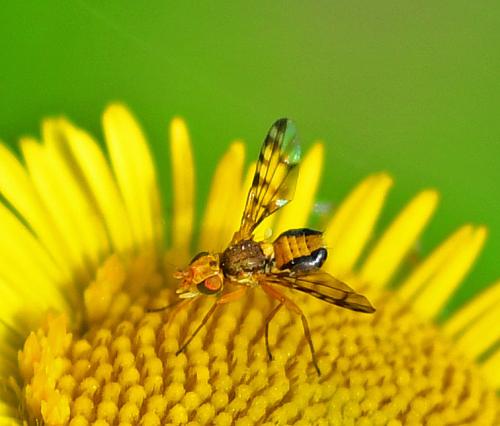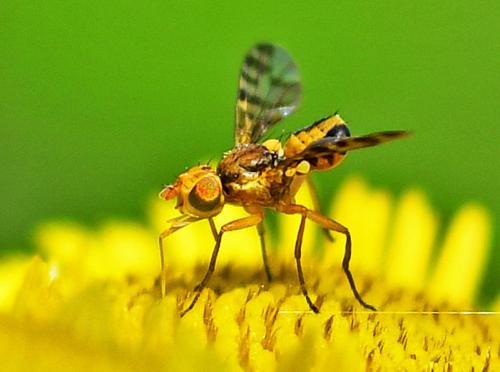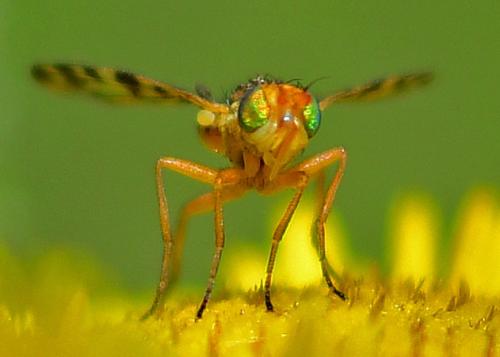Diptera.info :: Identification queries :: Diptera (adults)
|
Tephritidae Myopites apicatus ?
|
|
| Oryctes |
Posted on 06-08-2025 08:27
|
|
Member Location: Posts: 90 Joined: 21.08.19 |
 Oryctes : France : Villeneuve-d'Ascq : 59650 : 24/07/2025 Altitude : 23 m - Taille : 3 mm Réf. : 362804  Oryctes : France : Villeneuve-d'Ascq : 59650 : 24/07/2025 Altitude : NR - Taille : 3 mm Réf. : 362805  Oryctes : France : Villeneuve-d'Ascq : 59650 : 24/07/2025 Altitude : NR - Taille : 3 mm Réf. : 362806 Hello, I found this Tephritidae on July 24, 2025, at he edge of a lake in Villeneuve d'Ascq (Nord department in France). The insect was moving on Pulicaria dysenterica. I think this is a male of the species Myopites apicatus. However, I saw that a species M. longirostris existed and as I find that my little insect has a long (and angled) rostrum (profile photo) I have a doubt... Is it really the species Myopites apicatus here ? I have more pictures if needed. Thank you in advance for your opinion. Dominique |
|
|
|
| Nosferatumyia |
Posted on 06-08-2025 08:56
|
|
Member Location: Posts: 3545 Joined: 28.12.07 |
Yes, it is. Except the one thing: apicatus soon will be a junior synonym in my revision of the genus. Brilliant pictures, I'd kindly ask you to allow one of them for a cover, with your credits. Edited by Nosferatumyia on 06-08-2025 08:59 Val |
|
|
|
| Oryctes |
Posted on 06-08-2025 12:32
|
|
Member Location: Posts: 90 Joined: 21.08.19 |
Thank you, Val, for your reply and your opinion on the photos. OK for the "junior synonym" but synonym of what ? I find it hard to believe that a Tephritidae (Myopites longirostris) could have a longer proboscis than the one I photographied, so what differentiates the two species ? Of course and with pleasure you can use one of my photos. PS : I confess that I do not know the exact meaning of the expression "with your credits". Dominique Edited by Oryctes on 06-08-2025 12:35 |
|
|
|
| Nosferatumyia |
Posted on 06-08-2025 20:16
|
|
Member Location: Posts: 3545 Joined: 28.12.07 |
In fact, apicatus is the typically French type species of the Myopites, Myopites blotii Brebisson, 1827. Since the type specimen of blotii is missing, I have prepared a specimen from France to be its NEOTYPE, and even have got a DNA barcoding sequence. Most Myopites species (except a big African group) have similar proboscides. M. longirostris is a typical maritime coast dweller from Adriatics to England. It apparently has 2 seasonal forms, especially in Italy, Corsica, and Morocco. Its wing pattern is quite variable, but the colouration is darker and the wing patter less fumous; the apical veins in blotii are nearly parallel, and ovipositor is smooth, while in M. longirostris the tip of ovipositor is covered with pimples and the veins are under acute angle. M. blotii infests Pulicaria disenterica, and M. longirostris feeds in Limbarda crithmoides on salty shores near sea. The third species common in eastern Europe (not in France) is M. inulae Roder from Pentanema salicina and ensifolia. The other occur in the Middle East, Morocco, and Africa; one species endemic for Canary Is. Sequy (1934) key does not work. All other French nominal species are synonyms of blotii and longirostris. They correspond to "inulaedyssentericae Blot" and "eximia Seguy" in the key to British tephritida by White (1988) I keep on a beeeeeeeeeeg revision. Identification is difficult, and the nomenclature is very confused. I hope to finalize it while I am in Germany as a war refugee and alive. Unfortunately, I am busy with other projects and teaching, whih is slightly harder, when you are 70. Please keep an eye on my publications. Edited by Nosferatumyia on 06-08-2025 20:37 Val |
|
|
|
| Oryctes |
Posted on 07-08-2025 14:04
|
|
Member Location: Posts: 90 Joined: 21.08.19 |
Thank you so much, Val, for taking the time to explain all this with such precision. As you say, the long proboscis is shared by many species and therefore is not a relevant criterion for identification. Moreover there is no possible confusion between M. apicatus (soon blotii) and M. longirostris since, as you explain, these two species are not found in the same places, not on the same plant and differ in their appearance. I wish you courage and success for this beeeeeeeeeeg revision despite a difficult context and a lack of time. I will be happy to look at your publications as long as I know where to find them. Dominique |
|
|
|
| Jump to Forum: |












